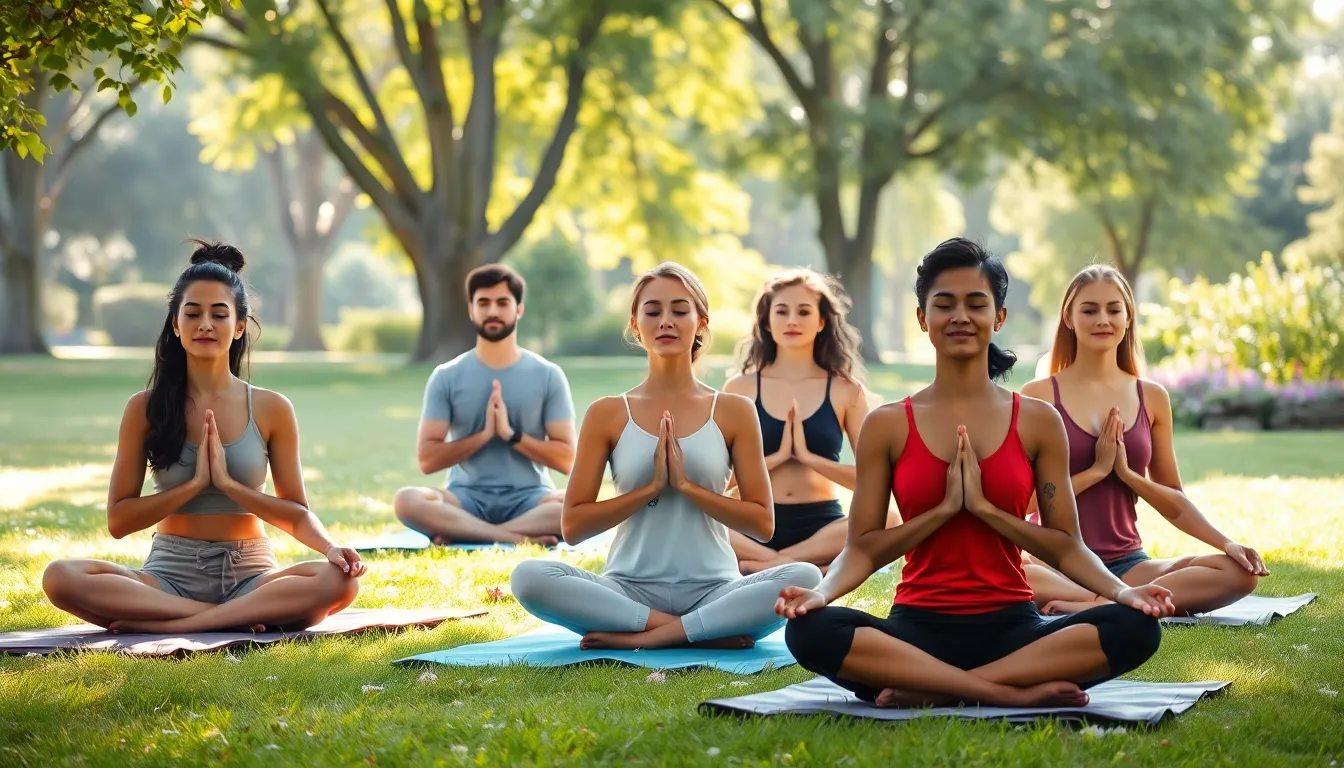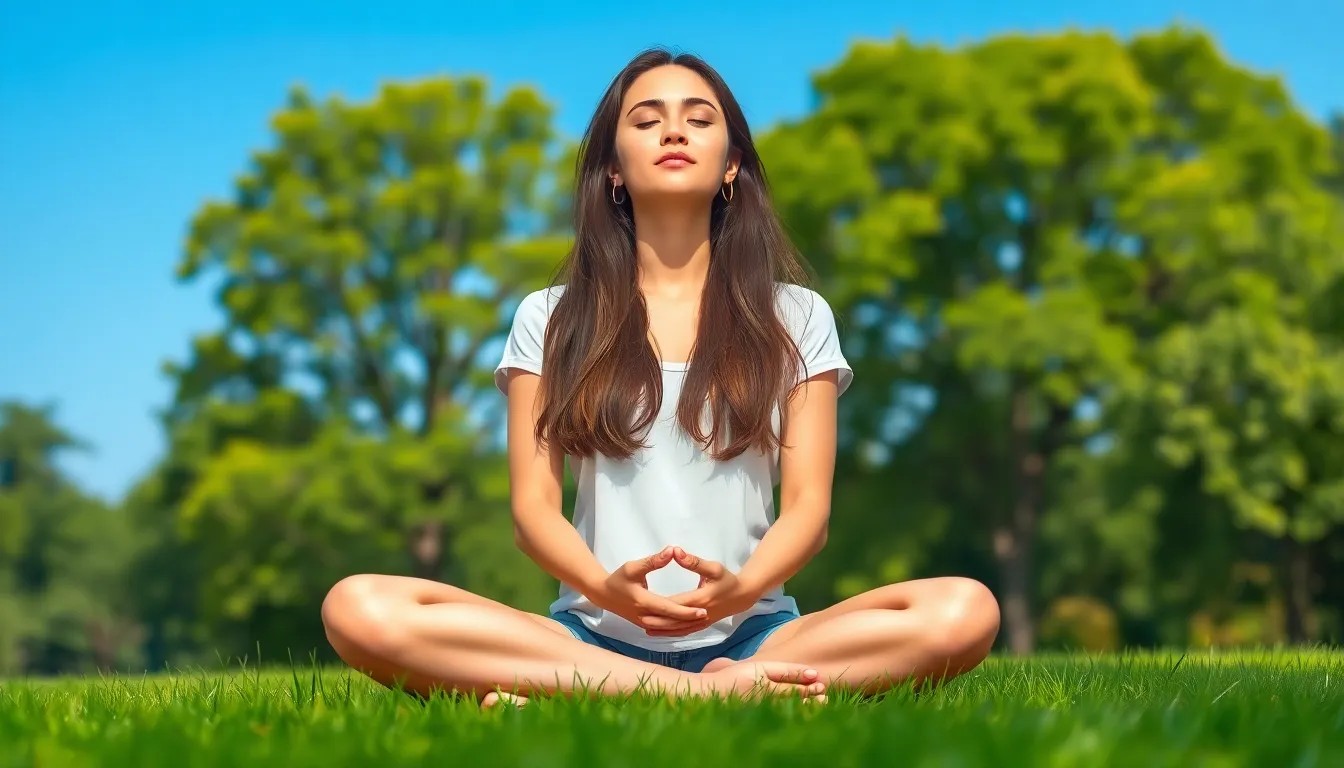In a world buzzing with distractions, finding a moment of peace can feel like searching for a unicorn in a haystack. Mindfulness techniques offer a refreshing escape from the chaos, helping to calm the mind and center the spirit. It’s like giving your brain a spa day—who wouldn’t want that?
Table of Contents
ToggleOverview of Mindfulness Techniques
Mindfulness techniques encompass various practices aimed at enhancing awareness and promoting emotional well-being. These methods often focus on present-moment attention to reduce stress and anxiety.
Meditation serves as a foundational technique. Practitioners usually sit quietly, concentrating on their breath or a specific thought, thereby fostering a deep sense of calm. Research shows that regular meditation can decrease symptoms of depression by up to 30%.
Another effective method includes mindful breathing. This technique emphasizes slow, intentional inhalation and exhalation. Focusing on each breath anchors individuals in the present, making it easier to manage overwhelming emotions.
Body scanning represents a third technique. Participants systematically focus on different parts of their body, noticing sensations and tensions. By practicing this, individuals improve their bodily awareness, which often leads to reduced physical discomfort.
Journaling presents a creative approach to mindfulness. Writing thoughts and feelings down enables individuals to reflect and gain clarity. Studies indicate that expressive writing can enhance mental health outcomes, particularly in those coping with trauma.
Walking meditation offers another pathway to mindfulness. This practice integrates movement with awareness, encouraging individuals to feel each step. Participants often find this method helpful for practicing mindfulness in everyday routines.
Lastly, mindful eating brings attention to the experience of consuming food. Paying attention to the taste, texture, and aroma of meals helps cultivate appreciation for nourishment. Research demonstrates that individuals who practice mindful eating often make healthier food choices.
These various mindfulness techniques provide practical tools for achieving mental clarity and emotional resilience in a hectic world.
Benefits of Mindfulness Techniques

Mindfulness techniques provide a range of benefits for both mental and physical health. These practices enhance overall well-being and improve quality of life.
Mental Health Benefits
Mindfulness techniques significantly reduce symptoms of anxiety and depression. They promote emotional resilience, enabling individuals to cope with stress better. Regular practice fosters self-awareness, allowing a deeper understanding of thoughts and feelings. People often experience increased focus and clarity, enhancing daily productivity. They also report improvements in mood and overall emotional stability. Studies show that engaging in mindfulness reduces rumination, leading to healthier coping mechanisms. Mindfulness techniques play a crucial role in enhancing mental health outcomes.
Physical Health Benefits
Physical health benefits emerge from mindfulness practices, too. Stress reduction through these techniques can lead to lower blood pressure. Improved sleep quality results from reduced stress and increased relaxation during mindfulness sessions. Studies indicate that consistent mindfulness practice enhances immune response, contributing to overall health. Individuals often notice a reduction in chronic pain and tension through practices like body scanning. Significant improvements in digestive health can also occur, especially with mindful eating techniques. Adopting mindfulness contributes to a healthier lifestyle and improved physical well-being.
Popular Mindfulness Techniques
Mindfulness techniques offer a variety of practices to enhance present-moment awareness and improve mental well-being. Each technique serves as a unique approach to fostering calmness and focus.
Mindful Breathing
Mindful breathing emphasizes the importance of focusing on breath. Practitioners inhale deeply, hold for a moment, and exhale slowly. This practice promotes relaxation and centers attention on the present. It helps individuals notice their thoughts without judgment. Regular practice of mindful breathing reduces anxiety levels and improves overall emotional regulation.
Body Scan Meditation
Body scan meditation encourages individuals to develop awareness of bodily sensations. Participants lie down comfortably and mentally scan through each part of their body. This practice fosters a connection between mind and body, helping practitioners recognize areas of tension. By paying attention to these sensations, individuals can release stress and promote relaxation. Consistent body scans lead to enhanced self-awareness and improved emotional health.
Guided Visualization
Guided visualization involves using imagery to promote relaxation and mental clarity. Practitioners listen to a guide who describes peaceful scenes or desired outcomes. This technique allows individuals to escape from stressors and create a mental sanctuary. Regular engagement in guided visualization can lead to reduced stress levels and improved focus. With consistent practice, it enhances overall emotional resilience and well-being.
Tips for Practicing Mindfulness
Mindfulness techniques thrive through consistent practice and overcoming challenges. Practitioners can embrace simple strategies to enhance their mindfulness journey.
Creating a Mindfulness Routine
Establish a daily routine to incorporate mindfulness effectively. Practicing at the same time each day helps build a habit. Starting with just five to ten minutes can lead to gradual increases in duration. Selecting a specific location free from distractions cultivates focus. Utilizing guided meditations or mindfulness apps offers structure and support. Engaging in diverse techniques, such as breathing or body scanning, keeps the practice fresh and engaging. Setting realistic goals encourages persistence and fosters a deeper connection to the practice.
Overcoming Common Obstacles
Recognizing potential obstacles helps address challenges faced during mindfulness practice. Time constraints often deter consistent practice. Scheduling mindfulness sessions into daily routines aids in overcoming this barrier. Distractions from technology or surroundings can interrupt focus. Creating a comfortable environment minimizes disturbances. Emotional resistance like restlessness or boredom may arise; acknowledging these feelings allows for smoother navigation. Practitioners can also remind themselves that mindfulness is a journey, not a destination. Progress may vary, emphasizing the importance of persistence over perfection.
Embracing mindfulness techniques can profoundly transform one’s mental and physical well-being. By dedicating time to practices like mindful breathing and body scanning, individuals can cultivate a sense of peace amid daily chaos. These techniques not only enhance self-awareness but also promote emotional resilience and healthier coping mechanisms.
As individuals incorporate mindfulness into their routines, they may notice significant improvements in focus, mood, and overall quality of life. The journey toward mindfulness is ongoing and requires patience and commitment. With consistent practice, the benefits can extend far beyond the individual, fostering a more compassionate and aware community.








